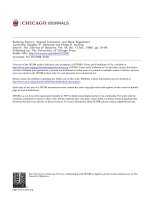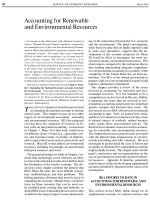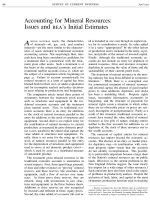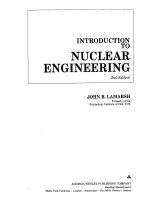CAS Online Course 2, Second Edition Insurance Accounting, Coverage Analysis, Insurance Law, and Insurance Regulation doc
Bạn đang xem bản rút gọn của tài liệu. Xem và tải ngay bản đầy đủ của tài liệu tại đây (71.17 KB, 14 trang )
CAS Online Course 2, 2
nd
Edition
© 2012, Casualty Actuarial Society and The Institutes, All Rights Reserved
C2-1
CAS Online Course 2, Second Edition
Insurance Accounting, Coverage Analysis, Insurance
Law, and Insurance Regulation
Notice about the 1
st
and 2
nd
Editions
1
st
Edition: The original CAS Online Course 2 (CA2, 1
st
Edition) was revised effective
September 1, 2012. Although the 1st Edition of CA2 is no longer available for sale after
August 31, 2012, for those who purchased the 1
st
Edition, the original online course will be
available and unchanged through June 15, 2013. The exam for the 1
st
Edition of CA2 will be
offered through June 15, 2013.
2
nd
Edition: CA2, 2
nd
Edition, is the current version that was effective on September 1, 2012.
Exams on this content will be offered for the first time on January 15, 2013.
Insurance Accounting, Coverage Analysis, Insurance Law, and Insurance Regulation is called Online
Course 2 by the CAS and CA2, 2
nd
Edition, by The Institutes. Prometric lists this course as CAS2 on its
website under The Institutes.
Online Course 2/CA2 prepares CAS candidates for a two-hour, seventy-five-point, multiple-choice
examination. The online course and exam were developed collaboratively with The Institutes. The online
course is available through the Casualty Actuarial Society Online Courses Web page
on The Institutes’
website. Similarly, the exam is administered by The Institutes at Prometric test centers during four, two-
month testing windows annually.
The study material for CAS Course 2/CA2 is contained in the online course access. The fee for access to
the online course includes one attempt at passing the exam. Candidates are required to purchase the
online course to obtain access to the exam. Exam retakes may be purchased separately if needed.
Purchasing the course requires that candidates declare the testing window in which they are planning to
take the exam. To register for the exam, a candidate must:
Call The Institutes at (800) 644-2101 or (610) 644-2100, extension 6000, to register for the exam
itself. This will place the candidate on an eligibility list for Prometric.
Then make an appointment with Prometric for a specific date and time during the testing window.
Early registration for the exam is strongly encouraged as seats fill quickly. There is a $105 fee for
changing testing windows.
Schedule your appointment when you know you will be ready to sit for the exam. Prometric will
charge a $50 fee to candidates who reschedule their appointments between 3 to 12 business days of a
test date. Changes to the appointment date/time are not permitted within 3 business days of the
appointment.
Questions or concerns regarding CAS Online Course 2/CA2 should be directed to The Institutes’
Customer Service Department at (800) 644-2101 or (610) 644-2100, extension 6000, or
.
CAS Online Course 2, 2
nd
Edition
C2-2
Assignment 1: Introductory Insurance Accounting
MODULE TITLE LEARNING OBJECTIVE
Qualitative Accounting Information Criteria Explain the following qualitative accounting
information criteria:
Understandability
Relevance
Reliability
Comparability and consistency
Lack of bias
Cost-benefit effectiveness
Types of Accounting Frameworks Describe the frameworks and the intended users and
focus of each of the following sets of accounting
frameworks:
Generally Accepted Accounting Principles
(GAAP) accounting
Regulatory/supervisory accounting
Tax accounting
Management accounting
Accounting Frameworks and Rule Hierarchies Explain the concept of a rule hierarchy and the
sources of the following accounting frameworks:
Generally Accepted Accounting Principles
(GAAP)
Regulatory/supervisory accounting
Tax accounting
Selected Accounting Concepts Summarize the following accounting concepts:
Fair value versus historical cost
Recognition versus measurement
Deferral-matching versus asset-liability
Impairment
Revenue recognition
Reporting segment
Liquidation versus going concern
Change in accounting principle versus change in
accounting estimate
Principle-based versus rule-based
Fundamentals of Insurer Financial Statements Describe the purpose and primary components of
these key schedules of an insurer’s financial
statements:
Balance sheet
Income statement
Cash flow statement
Notes and disclosures
Premium Accounting—Revenue Recognition Explain how and when insurers recognize premium
revenue in their financial statements under deferral-
matching and asset-liability approaches.
Premium Accounting—Types of Written
Premium
Distinguish between the various types of written
premium and policy transactions that may not be
classified as premium.
CAS Online Course 2, 2
nd
Edition
C2-3
Other Premium Accounting Issues Summarize the implications of these premium
accounting issues:
Financing—premiums versus service charges
Earning premium before it is written
Extended reporting endorsements (definite versus
indefinite periods)
Reinsurance lags
Large deductible credits
Unearned Premium Summarize the purpose of unearned premium and
these issues associated with how premiums are
earned over time:
Pro rata and non-pro rata approaches to earning
premium
Multiyear policies
Liability adequacy test and the premium
deficiency reserve
The Relationship Between Loss Reserves and
the Unearned Premium Reserve
Explain the relationship between loss reserves and the
unearned premium reserve.
Loss and Loss Adjustment Expense Accounting Describe the following issues related to loss and loss
adjustment expense (LAE) accounting:
Loss accounts
Loss cycle
Paid loss versus cash payment
Recoverable amounts
Accounting for discounted reserves
Self-insurer issues
Reinsurance Accounting Basics Explain the accounting and financial reporting
considerations, including how values in insurers’
financial reports are influenced by lags in the
reporting of reinsurance transactions and bordereau
reporting, for these types of reinsurance:
Assumed reinsurance
Ceded reinsurance
Commutations
Prospective versus retroactive reinsurance
Deposit Accounting Explain the conditions under which an accounting
framework may require deposit accounting for an
insurance contract, and the operation of three general
forms of deposit accounting rules.
CAS Online Course 2, 2
nd
Edition
C2-4
Assignment 2: Insurance Policy Analysis
MODULE TITLE LEARNING OBJECTIVE
Distinguishing Characteristics of Insurance
Policies
Describe the following characteristics of insurance
policies, including common exceptions to these
characteristics.
Indemnity
Utmost good faith
Fortuitous losses
Contract of adhesion
Exchange of unequal amounts
Conditional
Nontransferable
Structure of Insurance Policies Describe these approaches to insurance policy
structure and how they can affect policy analysis:
Self-contained and modular policies
Preprinted and manuscript policies
Standard and nonstandard forms
Endorsements and other related documents
Types of Policy Provisions Describe the purpose(s) and characteristics of each of
these types of policy provisions in a property-
casualty insurance policy:
Declarations
Definitions
Insuring agreements
Exclusions
Conditions
Miscellaneous provisions
Insurance Policy Analysis Describe the primary methods of insurance policy
analysis.
Assignment 3: Common Policy Concepts
MODULE TITLE LEARNING OBJECTIVE
Insurable Interest Given a case, evaluate one or more entities’ insurable
interests.
Insurance to Value Explain why insurance to value is important to
property insurers, how insurers encourage insurance
to value, and what insureds can do to address the
problems associated with maintaining insurance to
value.
Property Valuation Methods Explain how property is valued under each of the
following valuation methods in property insurance
policies:
Actual cash value
Replacement cost
Agreed value
Functional valuation
Valuation of Liability Claims Explain how the amount payable for a claim covered
under a liability insurance policy is determined.
CAS Online Course 2, 2
nd
Edition
C2-5
Reasons for Property Deductibles Explain how deductibles in property insurance benefit
the insured.
Liability Deductibles and Self-Insured
Retentions
Explain when and why deductibles and self-insured
retentions are appropriate for use in liability
insurance.
Other Sources Of Recovery Describe the multiple sources of recovery that may be
available to an insurance policyholder for a covered
loss.
Assignment 4: Personal Auto Policy: Liability, Medical Payments,
and Uninsured Motorist Coverage
MODULE TITLE LEARNING OBJECTIVE
Overview of the Personal Auto Policy Summarize the sections of the Personal Auto Policy.
Declarations Identify the types of information typically contained
on the declarations page of a personal auto policy.
Definitions Define the words and phrases included in the
definitions section of the Personal Auto Policy.
Part A - Liability Coverage Summarize each of the provisions in Part A—
Liability Coverage of the Personal Auto Policy.
Part A - Liability Coverage Case Given a case describing an auto liability claim,
determine whether Part A—Liability Coverage of the
Personal Auto Policy would cover the claim and, if
so, the amount the insurer would pay for the claim.
Part B - Medical Payments Coverage Summarize each of the provisions in Part B—
Medical Payments Coverage of the Personal Auto
Policy.
Part B - Medical Payments Coverage Case Given a case describing an auto medical payments
claim, determine whether Part B—Medical Payments
Coverage of the Personal Auto Policy would cover
the claim and, if so, the amount the insurer would pay
for the claim.
Part C - Uninsured Motorists Coverage Summarize each of the provisions in Part C—
Uninsured Motorists Coverage of the Personal Auto
Policy.
UM/UIM Endorsements and State Variations Describe underinsured motorists coverage in terms
of:
Its purpose
The ways in which it can vary by state
Part C - Uninsured Motorists Coverage Case Given a case describing an uninsured motorists claim,
determine whether Part C—Uninsured Motorists
Coverage of the Personal Auto Policy would cover
the claim and, if so, the amount the insurer would pay
for the claim.
CAS Online Course 2, 2
nd
Edition
C2-6
Assignment 5: Personal Auto Policy: Physical Damage, Duties
After an Accident, Endorsements, General Provisions
MODULE TITLE LEARNING OBJECTIVE
Part D - Damage to Your Auto Coverage Summarize each of the provisions in Part D—
Damage to Your Auto of the Personal Auto Policy.
Part D - Damage to Your Auto Coverage Case Given a case describing an auto physical damage
claim, determine whether Part D—Coverage for
Damage to Your Auto of the Personal Auto Policy
would cover the claim and, if so, the amount the
insurer would pay for the claim.
Part E - Duties After an Accident or Loss Identify the insured’s duties following an auto
accident or loss (Part E) covered by the Personal
Auto Policy.
Part F - General Provisions Summarize each of the general provisions in Part F of
the Personal Auto Policy.
Common Endorsements to the Personal Auto
Policy
Identify the Personal Auto Policy endorsements that
are used to handle common auto loss exposures.
Personal Auto Coverage Case Given a case describing an auto claim, determine
whether the Personal Auto Policy would cover the
claim and, if so, the amount the insurer would pay for
the claim.
Assignment 6: Homeowners Property Coverage
MODULE TITLE LEARNING OBJECTIVE
ISO Homeowners Program Describe how individuals and families can use the
ISO Homeowners insurance program to address their
personal risk management needs.
Homeowners Program Structure Summarize these aspects of the 2011 Homeowners
Program:
Structure of the Homeowners Policy (HO-3)
Key changes in the ISO 2011 Program Revision
Factors important to rating homeowners
insurance
HO-3 Section I - Property Coverages Determine whether the 2011 HO-3 policy provisions
in the following Section I - Property Coverages
provide coverage for a given loss or loss exposure:
Coverage A - Dwelling
Coverage B - Other Structures
Coverage C - Personal Property
Coverage D - Loss of Use
Additional Coverages
HO-3 Section I - Perils Insured Against and
Exclusions
Summarize each of the 2011 HO-3 policy provisions:
Perils Insured Against
Exclusions
HO-3 Section I - Conditions Summarize each of the 2011 HO-3 policy provisions
in Section I - Conditions.
CAS Online Course 2, 2
nd
Edition
C2-7
2011 HO-3 Section I - Property Coverage Case Given a scenario describing a homeowners property
claim, determine whether the 2011 HO-3 Policy
Section I - Property Coverages would cover the
claim, and if so, the amount the insurer would pay for
the claim.
Assignment 7: Homeowners Liability, Conditions, Coverage
Forms, and Endorsements
MODULE TITLE LEARNING OBJECTIVE
HO-3 Section II - Liability Coverages Determine whether the 2011 HO-3 Policy provisions
in the following Section II - Liability Coverages
provide coverage for a given loss or loss exposure:
Coverage E - Personal Liability
Coverage F - Medical Payments to Others
Additional Coverages
HO-3 Section II - Exclusions Determine whether one or more exclusions preclude
the coverage provided by Section II of the 2011 HO-3
policy provisions in Section II - Exclusions.
HO-3 Section II - Conditions Summarize each of these 2011 HO-3 policy
provisions:
Conditions applicable to Section II
Conditions applicable to Sections I and II
Homeowners Coverage Forms and Causes of
Loss Comparison Summary to the HO-3
Compare the coverage provided by each of the
following 2011 Homeowners policies to the coverage
provided by the 2011 HO-3 policy:
HO-2 Broad Form
HO-5 Comprehensive Form
HO-4 Contents Broad Form
HO-6 Unit-Owners Form
HO-8 Modified Coverage Form
Commonly Used Endorsements that Modify the
2011 ISO Homeowners Policies
Summarize the coverages provided by various 2011
ISO Homeowners policy endorsements.
HO-3 Coverage Case Given a case describing a homeowners claim,
determine whether a 2011 HO-3 Policy that may
include one or more endorsements would cover the
claim, and, if so, the amount the insurer would pay
for the claim.
Assignment 8: Commercial Property Insurance, Part l
MODULE TITLE LEARNING OBJECTIVE
Overview of the Commercial Property Insurance Describe commercial property insurance in terms of
these elements:
The major categories of loss exposures that can
be covered
The components of a commercial property
coverage part
CAS Online Course 2, 2
nd
Edition
C2-8
BPP Covered Property Determine whether a described item of property
qualifies as Covered Property under one or more of
these categories in the Building and Personal
Property Coverage Form:
Building
Your Business Personal Property
Personal Property of Others
BPP Additional Coverages and Coverage
Extensions
Determine which of the additional coverages and
coverage extensions of the Building and Personal
Property Coverage Form apply to a described loss.
Causes of Loss—Basic Form and Broad Form Determine whether the cause of a described loss is a
covered cause of loss under either the Causes of
Loss—Basic Form or the Causes of Loss—Broad
Form.
Cause of Loss—Special Form Determine whether the cause of a described loss is a
Covered Cause of Loss under the Causes of Loss—
Special Form.
BPP Limits of Insurance and Deductibles Apply the Limits of Insurance and Deductible
provisions of the Building and Personal Property
Coverage Form to a described loss.
Assignment 9: Commercial Property Insurance, Part lI
MODULE TITLE LEARNING OBJECTIVE
BPP Loss Conditions and Additional Conditions Explain how each of the Loss Conditions and
Additional Conditions affects coverage under the
Building and Personal Property Coverage Form.
BPP: Optional Coverages Explain how each of the following optional coverages
described in the BPP modifies the basic coverage of
the BPP:
Agreed Value
Inflation Guard
Replacement Cost
Extension of Replacement Cost to Personal
Property of Others
Commercial Property Conditions Summarize each of the Commercial Property
Conditions.
Common Policy Conditions Explain how each of the conditions contained in the
Common Policy Conditions affects coverage under a
commercial property coverage part.
Commercial Property Endorsements Explain how each of these documents modifies the
Building and Personal Property Coverage Form:
Ordinance or Law Coverage endorsement
Spoilage Coverage endorsement
Flood Coverage endorsement
Earthquake and Volcanic Eruption Coverage
endorsement
Peak Season Limit of Insurance endorsement
Value Reporting Form
CAS Online Course 2, 2
nd
Edition
C2-9
Factors Affecting Commercial Property
Premiums
Identify the factors that affect commercial property
insurance premiums
Determining Whether the BPP Covers a Loss Given a case, determine whether, and for what
amount, a described loss would be covered by a
commercial property coverage part that includes the
Building and Personal Property Coverage Form and
any of the three causes of loss forms.
Assignment 10: Commercial General Liability Insurance, Part l
MODULE TITLE LEARNING OBJECTIVE
Overview of Commercial General Liability
Insurance
Describe commercial general liability insurance in
terms of these elements:
The types of losses that can be covered by
general liability insurance
The components of a commercial general liability
coverage part
CGL Coverage A—Insuring Agreement Determine whether a described claim meets the
conditions imposed by the Coverage A insuring
agreement of the Commercial General Liability
Coverage Form (occurrence version).
CGL Coverage A—Exclusions Determine whether any of the exclusions applicable
to Coverage A of the Commercial General Liability
Coverage Form eliminate coverage for a described
claim.
CGL Coverage B—Personal and Advertising
Injury Liability
Determine whether a described claim meets the
conditions imposed by the Coverage B insuring
agreement of the Commercial General Liability
Coverage Form and whether any of the Coverage B
exclusions eliminate coverage for the claim.
CGL Coverage C—Medical Payments Determine whether a described claim meets the
conditions imposed by the Coverage C insuring
agreement of the Commercial General Liability
Coverage Form, and whether any of the Coverage C
exclusions eliminate coverage for the claim.
CGL Supplementary Payments Summarize the supplementary payments of the
Commercial General Liability Coverage Form.
Assignment 11: Commercial General Liability Insurance, Part ll
MODULE TITLE LEARNING OBJECTIVE
CGL Who Is an Insured Provisions Determine whether a described person organization is
an insured under the Commercial General Liability
Coverage Form.
CGL Limits of Insurance Explain how the following limits of insurance in the
CGL Coverage Form are applied:
Each occurrence limit
Personal and advertising injury limit
Damage to premises rented to you limit
Medical expense limit
General aggregate limit
Products-completed operations aggregate limit
CAS Online Course 2, 2
nd
Edition
C2-10
CGL Conditions Apply the Commercial General Liability Conditions
to claims or other interactions between the insurer
and the insured.
Rating CGL Coverage Explain how the premium for CGL coverage is
determined.
Determining Whether the CGL Covers a Claim
Case
Given a case, determine whether, and for what
amount, the Commercial General Liability Coverage
Form (occurrence version) covers a described claim.
Assignment 12: Specialty Coverages
MODULE TITLE LEARNING OBJECTIVE
Commercial Excess and Umbrella Liability
Insurance
Describe commercial excess liability insurance and
commercial umbrella liability insurance in terms of
these characteristics:
The three basic types of commercial excess
liability insurance
The provisions commonly found in commercial
umbrella liability policies that distinguish them
from other types of commercial liability policies
Professional Liability and Management Liability
Insurance
Describe professional liability insurance and
management liability insurance in terms of these
aspects:
How they differ from each other
How they differ from commercial general
liability policies
The common types of professional and
management liability policies
Environmental Insurance Describe the purpose and characteristics of each of
these types of environmental insurance policies:
Site-specific environmental impairment liability
(EIL) policies
Underground storage tank compliance policies
Remediation stop-loss policies
Contractors pollution liability policies
Environmental professional errors and omissions
liability policies
Aircraft Insurance Describe aircraft insurance in terms of these
characteristics:
The purposes-of-use categories that insurers used
to classify aircraft
The coverages that can be included in an aircraft
policy
Cyber Risk Insurance Describe the types of losses that can be covered by
each of the insuring agreements generally available in
cyber risk insurance policies.
Insuring Foreign Operations Explain how an organization domiciled in the United
States can insure foreign loss exposures that would
not be covered under standard property and liability
insurance policies.
CAS Online Course 2, 2
nd
Edition
C2-11
Terrorism Endorsements for Commercial
Property and Liability Forms
Summarize the purpose and provisions of the
terrorism endorsements developed by Insurance
Services Office, Inc., and the National Council on
Compensation Insurance, Inc.
Types of Surety Bonds Summarize the guarantee provided by the particular
types of surety bonds within the following bond
classifications:
Contract bonds
License and permit bonds
Public official bonds
Court bonds
Miscellaneous bonds
Assignment 13: Insurance Law, Part l
MODULE TITLE LEARNING OBJECTIVE
Tort Law Explain these concepts:
Tort as distinguished from other offenses
Classifications of tort
Application of laws in tort cases
Negligence Describe negligence claims in terms of:
The elements of negligence
The required proof of negligence
Defenses Against Negligence Claims Describe these defenses against negligence claims:
Comparative negligence, releases and exculpatory
clauses, immunity, statutes of limitations and repose,
tortfeasor’s capacity.
Liability of Landowners or Occupiers of Land Explain how negligence applies to landowners or
occupiers of land.
Intentional Torts Part 1 of 2 Describe these intentional torts, the circumstances
under which they can occur, and common defenses to
them:
Battery
Assault
False imprisonment and false arrest
Intentional infliction of emotional distress
Defamation (libel and slander)
Invasion of the right of privacy
Intentional Torts Part 2 of 2 Describe these intentional torts, the circumstances
under which they can occur, and common defenses to
them:
Fraud
Bad faith, or outrage
Interference with relationships between others
Misuse of legal process
Trespass
Nuisance
Conversion
CAS Online Course 2, 2
nd
Edition
C2-12
Liability in Extraordinary Circumstances Explain how liability attaches as a result of the
unique circumstances presented by the following:
Ultrahazardous activities
Ownership and/or possession of animals
Escape of toxic substances
Assignment 14: Insurance Law, Part ll
MODULE TITLE LEARNING OBJECTIVE
Products Liability Describe these causes of action for products liability
and the possible defenses to them:
Misrepresentation
Breach of warranty
Strict liability and negligence
Professional Liability Describe professional and directors and officers
liability.
Damages in Tort Suits Describe the types of damages a court can award a
plaintiff for a tort claim.
Equitable Remedies Explain these equitable remedies:
Specific performance
Injunction
Factors Affecting Amounts and Payment of
Damages
Summarize these legal concepts related to negligence
damages and remedies:
Restitutio in integrum
Mitigation of damages
Aggravated damages
Structured settlements and judgments
Liability Concepts Affecting Tort Claims Explain how any of these concepts can affect a tort
claim:
Joint tortfeasor’s liability
Expanded liability concepts
Vicarious liability
Good Samaritan issues
Class actions
Trends in Tort Litigation Summarize these trends in tort litigation:
Class action litigation
Litigation funding
Punitive damages
Tort reform
Assignment 15: Insurance Regulation
MODULE TITLE LEARNING OBJECTIVE
Economic Impact of the Insurance Industry Explain the economic impact of the insurance
industry.
The Objectives of Insurance Regulation Describe the objectives of insurance regulation.
CAS Online Course 2, 2
nd
Edition
C2-13
The Sources of Insurance Regulation Describe the three sources from which insurance
regulatory powers originate:
Legislation
Judicial review
Administrative agencies
The Structure of Insurance Regulations Describe the structure of insurance regulations.
Elements of Rate Regulation and Ratemaking Describe the following elements of rate regulation
and ratemaking:
Purpose and unique qualities of the insurance
industry
Actuarial ratemaking principles and considerations
in rate regulation
Insurance advisory organizations
Types of Rate Regulations Compare the following types of rate regulation:
Prior approval
File and use
Use and file
Open competition
Flex rating
Government-mandated rates
Effects of Rate Regulation on Insurers Summarize the effects of rate regulation on these
aspects of insurance:
Resources required for complying with rate
regulations
The underwriting cycle
Insurers’ decision making regarding where to
operate
Study Materials for CAS Online Course 2
The online course itself contains learning objectives and all the educational material to meet these
objectives and successfully complete the exam. The course fee includes one attempt at the exam.
The following printed materials are supplemental and may also be purchased from The Institutes, but are
not required:
Textbook contains material that is identical to the online course—only in a hardcopy format.
Review Notes is a condensed version of the textbook.
Course Guide contains sample questions and answers.
Flashcards contain key words and phrases.
The materials described above may be purchased individually or in various package combinations.
Questions about potentially defective questions or material should be directed to The Institutes’
Customer Service Department at (800) 644-2101 or (610) 644-2100, extension 6000, or
Publisher and Distributor
CAS Online Course 2/CA2, 2
nd
Edition is available through The Institutes.
The Institutes, 720 Providence Road, Suite 100, Malvern, PA 19355-3433; telephone: (800) 644-
2101 or (610) 644-2100 extension 6000; e-mail:; Web page
for CAS Online Courses: www.aicpcu.org/cas.htm
.
CAS Online Course 2, 2
nd
Edition
C2-14
Exam Results
Candidates taking this computer-based test will receive unofficial pass/fail results at the conclusion of
their exam. The unofficial pass/fail result will be displayed on the computer screen at the conclusion of
the exam. In most test centers, a printed copy of the candidate’s unofficial pass/fail result will be
available upon completion of the computer-based test from the proctor in the administrative area outside
the testing room. The candidate, however, should carefully read the result that is displayed on the
computer screen at the conclusion of the exam.
When the official grades have been processed, candidates will receive an e-mail from The Institutes
stating that their grades are available. Candidates may then log into their account on The Institutes
website (www.TheInstitutes.org
) to access their grades. The grade report for each candidate will show
the candidate’s overall score on the exam in ten point increments (e.g., 60 to 69%, 70 to 79%, and so on).
It will similarly show the candidate’s performance by assignment using those same ten point increments.
Numeric scores are not released. Approximately three weeks after the close of the testing window, The
Institutes will send a copy of the grades directly to the CAS Office to be added to the candidates’
admissions records.









